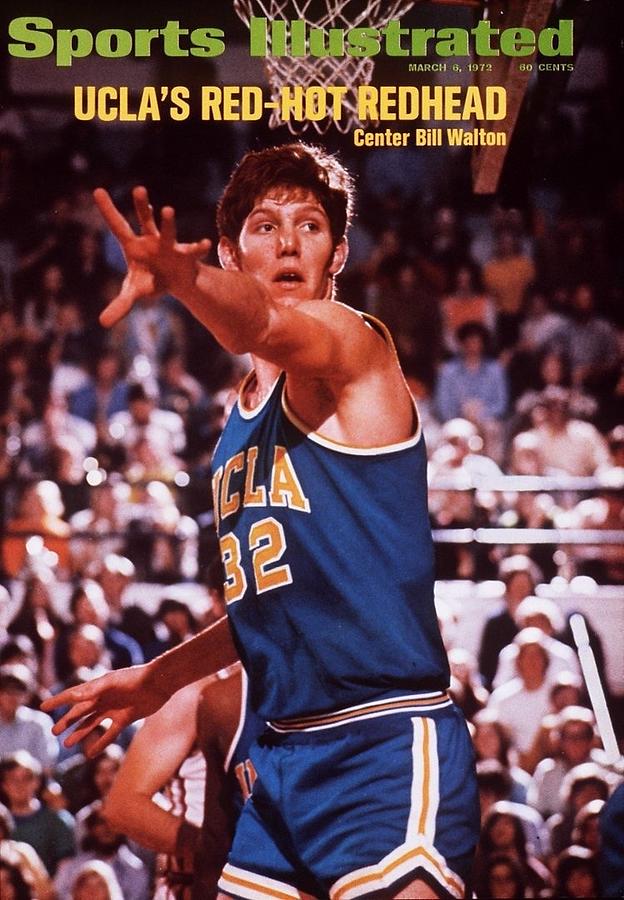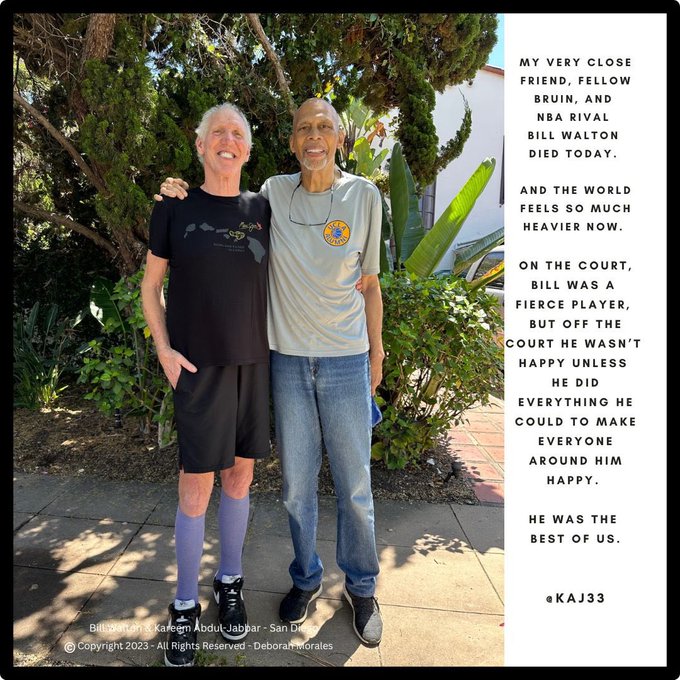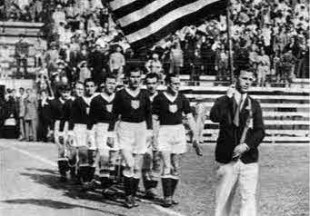If Bill Walton had never existed, and someone tried to create a fictional character based on him, no one would believe it.
William Theodore Walton III was born on November 5, 1952 in the San Diego suburb of La Mesa, California. His older brother Bruce (1951-2019) was a guard for the Dallas Cowboys from 1973 to 1975, his last game being Super Bowl X, which they lost to the Pittsburgh Steelers.
Like Bruce, his younger sister Cathy, and youngest brother Andy, he went to Helix High School in La Mesa. Other notable Helix graduates include football players Reggie Bush and Alex Smith, and actor Dennis Hopper. Between his sophomore and junior years, he grew from 6-foot-1 to 6-foot-7; by the time he graduated, he was 6-foot-11.
But his injury curse had already began: At Helix, he broke an ankle, a leg, and several bones in his feet. Before his sophomore season, he underwent surgery to repair torn cartilage on his left knee. He still managed to lead Helix to 49 straight wins and 2 State Championships.
Bill Walton was a loner, Dottie. A rebel. Yet he wanted to play basketball for the best coach in the college game, John Wooden of the University of California at Los Angeles. Having already led UCLA to the National Championship in 1964, 1965, 1967, 1968, 1969 and 1970, Wooden wanted him, too, and may have been the only coach who could make him fulfill his potential.
Until 1972, NCAA rules prohibited freshmen from playing on varsity teams, except in emergency conditions; so Wooden won the 1971 National Championship without Walton. Together, they won the National Championship in 1972 and 1973, and forged an 88-game winning streak from January 23, 1971 to January 19, 1974 that remains the record for men's college basketball. This included Walton's 21-for-22 shooting in the 1973 Final against Memphis State. In 1973, the Amateur Athletic Union (AAU) gave him the James E. Sullivan Memorial Award, as America's outstanding amateur athlete.
This was in spite of Walton's choice not to play for the U.S. team in the 1972 Olympics in Munich, Germany. At the time, it was thought to be because of his opposition to the Vietnam War. But it wasn't true: It was due to his bad experience at the 1970 World Championships, in Yugoslavia, under coach Hal Fisher. In a 2004 interview with ESPN, Walton said, "For the first time in my life, I was exposed to negative coaching and the berating of players, and the foul language, and the threatening of people who didn't perform."
In the men's basketball final, the U.S. controversially lost to the Soviet Union, 51-50. According to Russian sports historian Robert Edelman, "When they saw who was and wasn't on the U.S. team, that's when they started feeling like they'd actually have a chance. They followed American basketball closely, and they knew that no Walton was going to be a big deal." James Forbes was on that U.S. team, and he said, "If he plays, all of this becomes academic." Much like, that same month, if Bobby Orr hadn't been hurt, or if the NHL had led WHA defector Bobby Hull play for Canada, that hockey "Summit Series" doesn't go to the last minute of the last game.
(Speaking of Edelman: I heavily recommend his 2012 book about one of the world's great soccer teams, also a good work of Soviet national history: Spartak Moscow: A History of the People's Team in the Workers' State.)
A joke went around that "UCLA" stood for "U Can't Lose to Anybody." On January 19, 1974, UCLA traveled to play Notre Dame away. Coached by Richard "Digger" Phelps, and led by a freshman from Washington, D.C. named Adrian Dantley, the Fighting Irish -- who, 3 years earlier, were the last team to beat UCLA -- were 9-0, and ranked Number 2. Unlike UCLA's 1968 loss to the University of Houston at a packed Astrodome, this game was not billed beforehand as a "Game of the Century."
Had it been, it would have lived up to the hype. UCLA led by 11 points with 4 minutes to play. But Notre Dame went on a tear, and, with 6 seconds to go, took their 1st lead of the game, 71-70. One last-gasp effort by Walton missed, and the streak was over. (The University of Connecticut women's team broke the record with a 90-game streak, 2008-10.)
People who met Bill Walton were advised to never, ever mention this game to him. In his 1993 memoir Nothing But Net, he said it still bothered him. He complained about it many times afterward.
One week later, on January 26, there was a rematch at Pauley Pavilion in Los Angeles, and UCLA got its revenge, 94-75. Notre Dame finished the season 26-3, losing to Michigan in the NCAA Tournament's round of 16.
UCLA would get to the Semifinal, then lose to a North Carolina State team led by David Thompson. N.C. State then beat Marquette for the title. Without the graduating Walton, Wooden led UCLA to 1 last National Championship in 1975, and retired, winning 10 in 12 years. No other school has won that many. UCLA has since won an 11th title, in 1995.
Did I mention that Walton was a rebel? He wanted to grow his hair long, and to grow a beard. Wooden told him no. Walton took the high road, and calmly explained to Wooden that he was an adult, over age 18, and had the right to express himself that way; and, as an employee of a State university, Wooden had no right to stop him.
Wooden -- who also continued to call his previous big star, Kareem Abdul-Jabbar, formerly named Lew Alcindor, "Lewis," and Kareem let him because of his high regard for him -- said, "William, I respect your right to express yourself. I'm sorry to see you go." Wooden was right: He did have the right to set rules for his players, and that if Walton wanted to break those rules, he would not play.
Walton's senior year, 1973-74, was the time of Watergate. He took a sheet of stationery with the UCLA masthead on it, wrote a letter on it, demanding that President Richard Nixon resign, and got all the UCLA basketball players to sign it. He then gave it to Wooden to sign. Wooden wouldn't sign it. Not because he thought Nixon should stay in office, but because the letter was on official UCLA stationery, and sending it would be tantamount to the school making the resignation demand its official policy. And Wooden was not willing to compromise the school that way. Walton understood.
*
Walton was drafted by the Portland Trail Blazers. At first, he looked like tennis star Bjorn Borg: The Swede had long blond hair, wore a headband, and, just as some hockey players grow "playoff beards," he grew a beard only during Wimbledon. Walton had red hair, but the Blazers' red jerseys and a matching red headband were even redder than the hair and beard he was finally allowed to grow.
But hippie-ish Portland was his kind of place. He rode a bicycle from his apartment to the Portland Memorial Coliseum. He became a vegetarian, and began meditating. He began leaving tickets for his favorite band, the epitome of hippiedom: The Grateful Dead. He claimed to have seen them play over 850 concerts, including joining them on drums in a 1978 concert. At the Pyramids in Egypt. The band nicknamed him "Grateful Red."
Walton would later compare the Dead to a basketball team: There were five of them, they were a team, people traveled around to watch them perform, and their performances often included improvisation. "Of course," he said, "unlike a basketball team, the Grateful Dead have no opponents, unless you consider the police."
But the injury bug struck him again. He played only 35 games in 1974-75, rendering him unable to win the NBA's Rookie of the Year. (His UCLA teammate, Jamaal Wilkes, won it.) He was limited to 51 games in 1975-76. And he played 65 out of the 82 games in 1976-77.
But it was enough. The Blazers' head coached was Dr. Jack Ramsay, a Philadelphia native with a doctorate in education from the University of Pennsylvania. He had been the general manager of the Philadelphia 76ers when they won the 1967 NBA Championship. Blazers owner Larry Weinberg and general manager Harry Glickman hired Ramsay away from the Buffalo Braves in 1976.
And that 1st season in Portland, even more than the 68-13 1966-67 title season in Philadelphia, was Ramsay's masterstroke. A record of 49-33 was not particularly outstanding. But, talent-wise, they were: With Bill Walton at center; Maurice Lucas, Bob Gross, Corky Calhoun, Larry Steele and Lloyd Neal as forwards; and Lionel Hollins, Johnny Davis and Dave "Pinball" Twardzik as guards, the Blazers played the kind of artistic basketball that had rarely been seen: By the early 1970s New York Knicks, or maybe by one team or another in the ABA, but that was it.
In the Playoffs, the Blazers beat the Chicago Bulls, 2 games to 1; the Denver Nuggets, 4 games to 2; and the Los Angeles Lakers in 4 straight, including a signature dunk by Walton over his fellow UCLA graduate Kareem. In the Finals, the 76ers won the 1st 2 games, but the Blazers won the last 4, including a thrilling clincher in Portland in Game 6, 109-107. Walton was named the Most Valuable Player of the Finals.
In the locker room after that game, Ramsay -- who had previously coached Wilt Chamberlain in Philadelphia -- told the media, "I've never coached a better player, I've never coached a better competitor, and I've never coached a better person than Bill Walton." Walton, who, by this point, had ditched the headband and the long hair, but not the beard, said little: He was still badly affected by a stutter that he would later overcome. But his smile told the story.
Left to right: Jack Ramsay, Larry Weinberg, Bill Walton & NBA Commissioner Larry O'Brien.
The championship trophy is now named for O'Brien.
For 11 months, from March 29, 1977 to February 28, 1978, the Portland Trail Blazers They went 70-15, counting the Playoffs, winning the franchise's 1st (and still only) NBA Championship. Walton was named the NBA's MVP in 1978. Boston Globe columnist and ESPN correspondent Bob Ryan said that this team played the game of basketball as well as it has ever been played.
Ryan also called them "the greatest what-if story in the history of basketball. If that team stays healthy, and stays together, I think we're looking at 3 out of 4, 4 out of 6."
It may have been even better than that. The next 2 NBA Western Conference titles were won by the Seattle SuperSonics, a good team, but with only one Hall-of-Famer, and he wasn't even considered their best player yet: Dennis Johnson. The Lakers got Earvin "Magic" Johnson for the 1979-80 season, so the Blazers probably don't reach the Finals that year. But in 1981, the Houston Rockets had a losing record, and made the Playoffs as the West's 6th seed. The Blazers could have reached 3 straight Finals, and 4 out of 5, before the Lakers totally took over the West.
But on February 28, 1978, Bill Walton, the Trail Blazers' fulcrum, broke his foot. Although he returned for 2 games of the Playoffs that year, he was never the same player again, and it took the Blazers a decade to recover. He was unhappy about the way the team's medical staff handled him, and demanded a trade. They wouldn't do it, and he sat out the 1978-79 season -- not that his injury left him with another choice.
Following his retirement, Walton and the Blazer organization reconciled. But the team has never truly replaced him. Their quest for another dominating big man led them in 1984 to draft Sam Bowie instead of Michael Jordan, and in 2007 to draft Greg Oden instead of Kevin Durant. As with Walton, both Bowie and Oden had already had a major injury, and both would see their pro careers ruined by additional injuries.
When ESPN did an episode of The Top 5 Reasons You Can't Blame... on drafting Bowie instead of Jordan, one of the reasons was "The Curse of Bill Walton." Walton was interviewed for the show, and, with a smile, knowing that it wasn't a curse that he'd actually placed on the team, he said, "Blame me."
*
His contract having run out, he signed with his hometown team, the San Diego Clippers. But his injuries recurred. In 1979-80, Walton played only 14 games. He missed the 1980-81 season. He missed the 1981-82 season. He played 33 games in 1982-83. In other words, from February 28, 1978 to October 28, 1983, 5 1/2 years, he played only 47 of a possible 443 games -- 10.6 percent. As he said in 1981, after one of his surgeries, "Minor surgery is what they do to someone else."
He managed to get into 55 games in 1983-84. But it was too late for the team. A healthy hometown hero might have brought a sellout of 14,000 fans to the San Diego Sports Arena (now named the Pechanga Arena) for every game. But without the key figure, no one wanted to spend their money to watch professional basketball.
Number 7 is Bobby "Bingo" Smith.
Both men would get their numbers retired:
Smith by Cleveland, Walton by Portland,
and neither by the Clippers.
"When you fail in your hometown, that's as bad as it gets, and I love my hometown," Walton said. "I wish we had NBA basketball here, and we don't, because of me. It's my greatest failure as a professional in my entire life: I could not get the job done in my hometown. It is a stain and stigma on my soul that is indelible. I'll never be able to wash that off, and I carry it with me forever."
Walton was a bit hard on himself. He didn't get hurt on purpose. But if he had been healthy, maybe the Clippers would have survived in San Diego, instead of being moved to Los Angeles, where they were a joke franchise for nearly 30 years, and have still only reached the Conference Finals once in 54 seasons, in 3 cities: In 2021, losing to the Phoenix Suns.
He played 67 games for the Clippers in 1984-85, their 1st season in Los Angeles. Then Red Auerbach, president of the Boston Celtics, pulled off his last great transaction: He sent the Clippers Cedric "Cornbread" Maxwell and a 1st-round draft pick, eventually wasted on Arvydas Sabonis, then stuck behind the Iron Curtain, for Walton.
In the 1985-86 season, the Celtics went 67-15, including 40-1 at the Boston Garden. Ironically, it was Portland who dealt them their only home loss, on December 6. Walton, now 33, saw that Kevin McHale, a future Hall-of-Famer, was wearing his usual Number 32. So he added 3 plus 2, and wore Number 5.
Walton backed up center Robert Parish, with forwards McHale and Larry Bird, the on-court leader of that team, and the most popular player in Celtic history. The guards were Danny Ainge and the aforementioned Dennis Johnson. Also notable on that team was guard Rick Carlisle, who went on to coach the Dallas Mavericks to the 2011 NBA Championship, and the Indiana Pacers into this year's Eastern Conference Finals.
On a 1996 ESPN broadcast to debate the greatest NBA team ever, in which he also made the aforementioned comments about the '77 Blazers, Ryan nominated the '86 Celtics, calling them "the team that could beat you the most different ways. He said his best argument was that it was the only team that ever brought a healthy Bill Walton off the bench. Being the backup center was key for Walton: Not having the burden of being the starter, and averaging 19 minutes per game, instead of the 33 he usually averaged when healthy, he was able to play in 80 of the 82 regular-season games.
He also played in 14 of the 16 Playoff games: In all 3 of the Celtics' 3-game sweep of the Bulls, in all 5 of the Celtics' win over the Atlanta Hawks, in all 4 of the Celtics' 4-game sweep of the Milwaukee Bucks, and in 4 of the 6 games in the Finals, where the Celtics beat the Rockets, for their 16th NBA Championship, their 3rd in 6 years, and Walton's 2nd, making him one of the few players to win with 2 different teams.
Between them, the 7-foot-1 Parish and the 6-foot-11 Walton had little trouble against the Rockets' "Twin Towers" of 7-feet-even Hakeem Olajuwon and the 7-foot-4 Ralph Sampson. Sampson, next to Walton, is the patron saint of great college players whose injuries kept them from reaching their true pro potential.
Ryan called Walton "the most influential player ever to lace up a pair of sneakers." Walton was an all-time great, but Ryan knows better than that: He is old enough to have seen Bill Russell and Bob Cousy play against Wilt Chamberlain. Theoretically, he's old enough to have seen George Mikan play. But Ryan also said that Bird and Walton, playing together, "It was sinful. It was almost pathetic." He said, "They raised basketball to the level of something almost spiritual." Walton himself said, "Playing basketball with Larry Bird is like singing with Jerry Garcia."
Left to right: Walton, Bird, Parish
But it was only to be for that 1 season. He was injured again the next season, and played only 10 regular-season games. He played in the 1987 Finals, which the Celtics lost to the Lakers. He was 34 years old. He never played again. He still held out hope of a comeback, but finally announced his retirement in 1990.
"I would love to play one more game", Walton said he wished. "But then I would want to play another one. And another one. But I will take one."
*
The fact that he became a broadcaster surprised people who knew him. He credited the 1st great NBA broadcaster, Marty Glickman, with helping him overcome it. As Walton said:
I'm a stutterer. I never spoke to anybody. I lived most of my life by myself. But as soon as I got on the court, I was fine. But in life, being so self-conscious, red hair, big nose, freckles and goofy, nerdy looking face, and can't talk at all. I was incredibly shy and never said a word. Then, when I was 28, I learned how to speak. It's become my greatest accomplishment of my life, and everybody else's biggest nightmare.
He worked for CBS in 1990 and 1991, NBC from 1990 to 2002, the Clippers from 1990 to 2002, and ABC/ESPN from 2002 to 2009. He had to step aside due to terrible back pain and the subsequent spinal-fusion surgery. It was so bad, he could not walk into the hospital.
He was able to return to broadcasting in 2010, 2 seasons for the Sacramento Kings. In 2012, he returned to ESPN, and also joined the Pac-12 Network, broadcasting games on the West Coast, to stay close to home in San Diego. His hippie mindset led to some odd opinions on the air, endearing him to some, but not all.
Walton and his 1st wife, Susie, were married from 1979 to 1989. They had 4 sons: Adam, Nathan, Luke and Chris. In 1991, Bill married Lori Matsuoka, and they were together until death did they part.
Luke Walton, 6-foot-8, was a forward, was with the Lakers when they won the 2009 and 2010 NBA Championships. The Waltons thus became the 3rd father-son tandem to both win NBA titles, following the Matt Guokasas (Sr., 1947 Philadelphia Warriors; Jr., 1967 Philadelphia 76ers) and the Barrys (Rick, 1975 Golden State Warriors; Brent, 2005 and 2007 San Antonio Spurs). Luke was an assistant coach to Steve Kerr on the Golden State Warriors' 2015 title, was the Lakers' head coach from 2016 until 2019, and was the Sacramento Kings' head coach from then until 2021. Since 2022, he has been an assistant coach for the Cleveland Cavaliers.
Bill Walton was named to the Basketball Hall of Fame. The NBA named him to its 50th Anniversary 50 Greatest Players and its 75th Anniversary 75 Greatest Players. UCLA made its 1st 2 basketball retired numbers Kareem's Number 33 and Walton's Number 32. The Trail Blazers also retired his Number 32. (The Celtics retired Number 5, but for a later player, Kevin Garnett.)
He was elected to the San Diego Hall of Champions, the California Sports Hall of Fame, and the Oregon Sports Hall of Fame. In 2016, a statue of him was unveiled at Ski Beach Park in the Mission Bay section of San Diego.
In his life, he underwent 39 surgeries. Still, echoing baseball icon Lou Gehrig, he said, "I'm the luckiest guy on Earth."
Bill Walton moved to a new plane of existence today, May 27, 2024. He was 71 years old, and had cancer.
Hosting ESPN's Around the Horn today, Tony Reali said, "He will be lovingly referred to as an American original. I would like to respectfully question that, because that would mean that he was from this planet. And we all know Bill traveled intergalactically and on a multiverse plane."
On that same show, Clinton Yates pointed out that it was "almost poetically memorable" that Walton passed away at the same time as the league in which UCLA played, and for whom he broadcast, known in its last few years as the Pac-12.
Some other tributes:
* Larry Bird: "I am very sorry about my good friend, Bill Walton. I love him as a friend and teammate. It was a thrill for me to play with my childhood idol and together we earned an NBA Championship in 1986. He is one of the greatest ever to play the game. I am sure that all of my teammates are as grateful as I am that we were able to know Bill, he was such a joy to know and he will be sorely missed."
* Magic Johnson: "From shooting jump shots to making incredible passes, he was one of the smartest basketball players to ever live. Bill was a great ambassador for college basketball and the NBA, and he will be sorely missed."
* Julius Erving, another playing and style icon turned broadcaster: "I am sad today hearing that my comrade & one of the sports worlds most beloved champions & characters has passed. Bill Walton enjoyed life in every way. To compete against him & to work with him was a blessing in my life. Sorry for your loss Walton family. We’ll miss him too."
* John Fogerty, leader of rock band Creedence Clearwater Revival: "So sad that our friend Bill Walton has passed away. He was truly a very special and joyful person and his megawatt smile made everyone smile! His enthusiasm for life and all things rock and roll was unstoppable and we miss you Bill! Our love and prayers to Lori and family."
* Barack Obama, former President, basketball fan: "Bill Walton was one of the greatest basketball players of all time – a champion at every level and the embodiment of unselfish team play. He was also a wonderful spirit full of curiosity, humor and kindness. We are poorer for his passing."
Once, appearing on an ESPN broadcast, tie-dyed T-shirt on, a Hawaiian lei around his neck, he said, "It doesn't get any better than this."
We all have our definitions of that. But who am I to try to convince Bill Walton of mine?

















